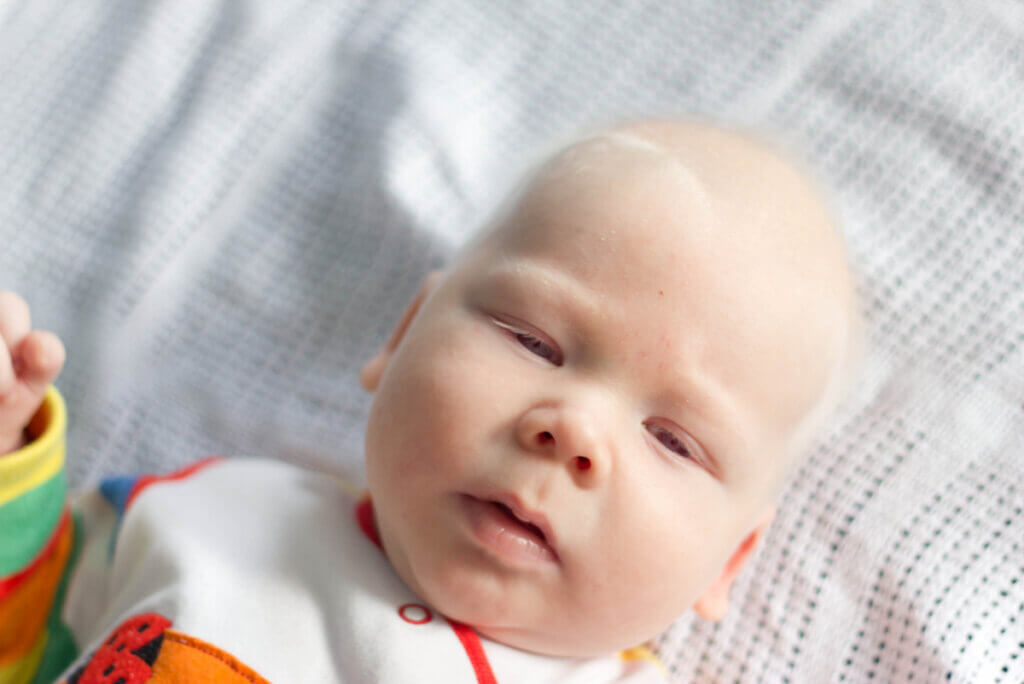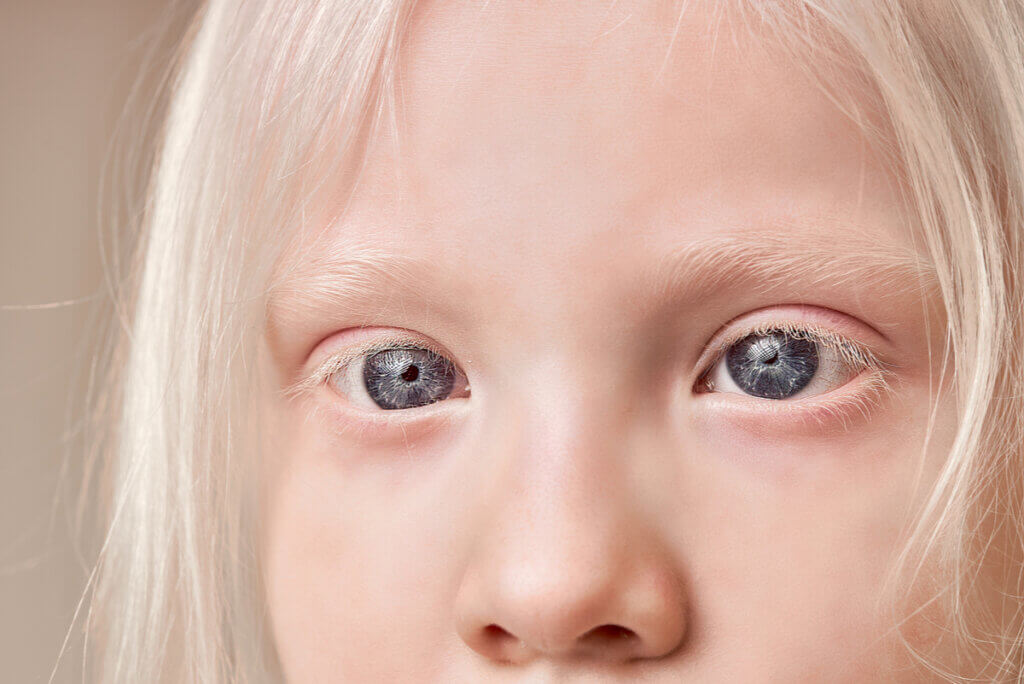What Is Albinism?


Escrito y verificado por el biólogo Samuel Antonio Sánchez Amador
Albinism is a heterogeneous genetic disorder caused by mutations that cause defects in the production of melanin, a pigment that gives living beings the color of their hair, eyes, and skin. According to the Madrid Biotechnology Center (CSIC), 1 in 17,000 people have some type of albinism.
Contrary to popular belief, the reality is that there’s no single type. Due to the genetic variability within the human species, albino people can present diverse physical and physiological signs with varying intensity and relevance.
Therefore, the most important characteristic that unites all people with this disorder is precisely the lack of melanin production. If you want to know more, don’t miss the information contained in the following article.
Statistical data
The National Organization for Albinism and Hypopigmentation and other sources show us the following figures:
- It’s estimated that 1 in 17,000 European and American people have some form of albinism. Other sources put this figure at 1 in 10,000 to 1 in 20,000. However, it’s a very rare disorder.
- According to the United Nations (UN), this condition is much more common in sub-Saharan Africa than in other regions. In certain populations of Zimbabwe and other specific ethnic groups in southern Africa, an incidence of 1 in 1000 people is reached.
- It’s estimated that in countries like Spain, based on their population numbers, today there should be some 2,600 people with some type of albinism.
Albinism isn’t acquired throughout life nor is it a disease. Lack of melanin from birth can lead to problems, but being albino isn’t a disease in itself.
For this reason, it’s very important to refer to albinism as an abnormal phenological and genetic condition or disorder, but not a disease. This is the only way to end the historical discrimination that albino people have suffered for hundreds of years.

The genetics of albinism
Albinism is an autosomal recessive genetic disorder. To understand the inheritance pattern of this condition, we have to establish some previous concepts in terms of genetics.
First of all, it’s important to note that a gene is a unit of information found in the nucleus of each cell. Each one of the genes that define us as a species and individuals is located in the chromosomes, occupying a place called a locus. For its part, an allele is each of the forms that a gene can present.
Let’s say that the allele that codes for albinism is (a) and the normal one is (A). If each gene has two alleles—one from the father and one from the mother—we can say that a non-albino person will be (AA) for albinism.
But albinism is a recessive condition and, therefore, has to be represented in both alleles of a gene to manifest itself. Therefore, a non-albino person can be (Aa) for that gene. This means that it contains information for albinism, but that it’s not expressed, as there’s only one copy of its allele in its genome.
Therefore, only (aa) people are albinos, and from there derives the recessive character of the condition. It’s also considered an autosomal disorder, as it’s not contained in the sex chromosomes, so it’s not linked to sex.
Inheritance pattern
This condition follows a Mendelian inheritance pattern and, therefore, meets the following rules:
- Few individuals present it, as there’s less probability of its expression compared to the dominant character.
- The distribution pattern is the same in males and females, as the inherited mutation isn’t present on the sex chromosomes.
- A non-carrier individual (AA) and an albino individual (aa) will give birth to non-albino offspring, but all offspring will be carriers (Aa).
- A carrier individual (Aa) and an albino individual (aa) will give birth to carrier offspring in 50% of cases and albino offspring in the other 50%.
- Two individuals who are carriers (Aa) will have a 25% chance of having an albino child (aa), a 50% chance of having non-albino carriers (Aa), and a 25% chance of having a child that’s not a carrier at all (AA).
- Two albino individuals (aa) will give rise to albino offspring in all cases.
Therefore, two non-albino people can have an albino child, although this is rare. It’s a question of statistics.
Types of albinism
According to the Elsevier medical portal, there are two main types of albinism: A general type and another that manifests itself specifically at the ocular level. We’ll analyze them in the following lines.
1. Oculocutaneous albinism (OCA)
Oculocutaneous albinism is the most obvious variant of the condition, affecting the eyes, hair, and skin. This type, the most well-known, is that which follows the previously described Mendelian inheritance pattern. For a person to be born albino, both parents must be albino, one albino and the other a carrier, or at least both carriers.
This variant includes signs such as hypopigmentation of the skin, hair, and eyes, foveal hypoplasia —decussation of the optic nerve— and decreased visual acuity, as indicated by optometry specialists.
It should be noted that, to date, 7 types of oculocutaneous albinism have been described, depending on the affected gene: OCA1, OCA2, OCA3, OCA4, OCA5, OCA6, and OCA7. There are also other much less common types, such as Hermansky-Pudlak syndrome (HPS) —with 9 subtypes— and Chediak-Higashi syndrome.
2. Ocular Albinism (OA)
As its name indicates, in this case, only the eyes show anomalous characteristics. It’s much less common than OCA and, furthermore, it doesn’t follow a Mendelian pattern of inheritance as described. In the case of OA, the mutations are found in the sex chromosomes.
The variability, in this case, is much less convoluted: The mutation is found in the GPR143 gene, which plays a very important role in eye pigmentation. This gene is located on the X chromosome.
It’s important to remember that albinism is a recessive disorder and, therefore, the majority of people with OA are men. Having only one copy of the X chromosome, it’s much more likely to occur in males than in females.
Ocular signs of albinism
According to the American Academy of Ophthalmology (AAO), some of the signs of this disorder at the ocular level are the following:
- Nystagmus: Involuntary movement of the eyes.
- Strabismus: Deviation of the eyes.
- Sensitivity to bright light, i.e. photophobia.
- Refractive errors or refractive defects, such as astigmatism, farsightedness, or myopia.
- Foveal hypoplasia: An event that we’ve already named. The retina doesn’t develop correctly during pregnancy and the individual’s childhood.
- Optic nerve and iris problems.

Other complications
According to the National Library of Medicine of the United States, albinism doesn’t shorten the life expectancy of those who present it, although syndromes such as HPS that display typical characteristics of albino people do. Even so, people with this condition often face 3 major problems:
- Vision: The lack of melanin pigment makes the eyes much more sensitive to the sun’s rays. That is why experts recommended the use of protective glasses that reduce light by 15% in closed spaces and 80% outdoors.
- Skin: The absence of melanin is also noticeable in the skin and, therefore, albino people (OCA) are at greater risk of sunburn when exposed to the sun. In some countries, many end up dying from skin cancer.
- Social problems: Previously cited sources estimate that in at least 25 African countries, albino people are persecuted and attacked for their condition. There are many personal testimonies collected by organizations such as UNICEF regarding the subject.
Albinism isn’t a disease
As you may have seen, albinism is significant on a genetic, medical, and sociocultural level. In summary, it’s important to understand that there’s not only one type of albinism: There are multiple degrees and genetic variability that play an essential role in its manifestation. It’s not a disease, but an abnormal and atypical condition.
Unfortunately, in many regions, the stigmatization and persecution of people with albinism continue to be a significant social problem. It’s crucial to inform the general population about the normality of this condition, as there are many prejudices around it.
Albinism is a heterogeneous genetic disorder caused by mutations that cause defects in the production of melanin, a pigment that gives living beings the color of their hair, eyes, and skin. According to the Madrid Biotechnology Center (CSIC), 1 in 17,000 people have some type of albinism.
Contrary to popular belief, the reality is that there’s no single type. Due to the genetic variability within the human species, albino people can present diverse physical and physiological signs with varying intensity and relevance.
Therefore, the most important characteristic that unites all people with this disorder is precisely the lack of melanin production. If you want to know more, don’t miss the information contained in the following article.
Statistical data
The National Organization for Albinism and Hypopigmentation and other sources show us the following figures:
- It’s estimated that 1 in 17,000 European and American people have some form of albinism. Other sources put this figure at 1 in 10,000 to 1 in 20,000. However, it’s a very rare disorder.
- According to the United Nations (UN), this condition is much more common in sub-Saharan Africa than in other regions. In certain populations of Zimbabwe and other specific ethnic groups in southern Africa, an incidence of 1 in 1000 people is reached.
- It’s estimated that in countries like Spain, based on their population numbers, today there should be some 2,600 people with some type of albinism.
Albinism isn’t acquired throughout life nor is it a disease. Lack of melanin from birth can lead to problems, but being albino isn’t a disease in itself.
For this reason, it’s very important to refer to albinism as an abnormal phenological and genetic condition or disorder, but not a disease. This is the only way to end the historical discrimination that albino people have suffered for hundreds of years.

The genetics of albinism
Albinism is an autosomal recessive genetic disorder. To understand the inheritance pattern of this condition, we have to establish some previous concepts in terms of genetics.
First of all, it’s important to note that a gene is a unit of information found in the nucleus of each cell. Each one of the genes that define us as a species and individuals is located in the chromosomes, occupying a place called a locus. For its part, an allele is each of the forms that a gene can present.
Let’s say that the allele that codes for albinism is (a) and the normal one is (A). If each gene has two alleles—one from the father and one from the mother—we can say that a non-albino person will be (AA) for albinism.
But albinism is a recessive condition and, therefore, has to be represented in both alleles of a gene to manifest itself. Therefore, a non-albino person can be (Aa) for that gene. This means that it contains information for albinism, but that it’s not expressed, as there’s only one copy of its allele in its genome.
Therefore, only (aa) people are albinos, and from there derives the recessive character of the condition. It’s also considered an autosomal disorder, as it’s not contained in the sex chromosomes, so it’s not linked to sex.
Inheritance pattern
This condition follows a Mendelian inheritance pattern and, therefore, meets the following rules:
- Few individuals present it, as there’s less probability of its expression compared to the dominant character.
- The distribution pattern is the same in males and females, as the inherited mutation isn’t present on the sex chromosomes.
- A non-carrier individual (AA) and an albino individual (aa) will give birth to non-albino offspring, but all offspring will be carriers (Aa).
- A carrier individual (Aa) and an albino individual (aa) will give birth to carrier offspring in 50% of cases and albino offspring in the other 50%.
- Two individuals who are carriers (Aa) will have a 25% chance of having an albino child (aa), a 50% chance of having non-albino carriers (Aa), and a 25% chance of having a child that’s not a carrier at all (AA).
- Two albino individuals (aa) will give rise to albino offspring in all cases.
Therefore, two non-albino people can have an albino child, although this is rare. It’s a question of statistics.
Types of albinism
According to the Elsevier medical portal, there are two main types of albinism: A general type and another that manifests itself specifically at the ocular level. We’ll analyze them in the following lines.
1. Oculocutaneous albinism (OCA)
Oculocutaneous albinism is the most obvious variant of the condition, affecting the eyes, hair, and skin. This type, the most well-known, is that which follows the previously described Mendelian inheritance pattern. For a person to be born albino, both parents must be albino, one albino and the other a carrier, or at least both carriers.
This variant includes signs such as hypopigmentation of the skin, hair, and eyes, foveal hypoplasia —decussation of the optic nerve— and decreased visual acuity, as indicated by optometry specialists.
It should be noted that, to date, 7 types of oculocutaneous albinism have been described, depending on the affected gene: OCA1, OCA2, OCA3, OCA4, OCA5, OCA6, and OCA7. There are also other much less common types, such as Hermansky-Pudlak syndrome (HPS) —with 9 subtypes— and Chediak-Higashi syndrome.
2. Ocular Albinism (OA)
As its name indicates, in this case, only the eyes show anomalous characteristics. It’s much less common than OCA and, furthermore, it doesn’t follow a Mendelian pattern of inheritance as described. In the case of OA, the mutations are found in the sex chromosomes.
The variability, in this case, is much less convoluted: The mutation is found in the GPR143 gene, which plays a very important role in eye pigmentation. This gene is located on the X chromosome.
It’s important to remember that albinism is a recessive disorder and, therefore, the majority of people with OA are men. Having only one copy of the X chromosome, it’s much more likely to occur in males than in females.
Ocular signs of albinism
According to the American Academy of Ophthalmology (AAO), some of the signs of this disorder at the ocular level are the following:
- Nystagmus: Involuntary movement of the eyes.
- Strabismus: Deviation of the eyes.
- Sensitivity to bright light, i.e. photophobia.
- Refractive errors or refractive defects, such as astigmatism, farsightedness, or myopia.
- Foveal hypoplasia: An event that we’ve already named. The retina doesn’t develop correctly during pregnancy and the individual’s childhood.
- Optic nerve and iris problems.

Other complications
According to the National Library of Medicine of the United States, albinism doesn’t shorten the life expectancy of those who present it, although syndromes such as HPS that display typical characteristics of albino people do. Even so, people with this condition often face 3 major problems:
- Vision: The lack of melanin pigment makes the eyes much more sensitive to the sun’s rays. That is why experts recommended the use of protective glasses that reduce light by 15% in closed spaces and 80% outdoors.
- Skin: The absence of melanin is also noticeable in the skin and, therefore, albino people (OCA) are at greater risk of sunburn when exposed to the sun. In some countries, many end up dying from skin cancer.
- Social problems: Previously cited sources estimate that in at least 25 African countries, albino people are persecuted and attacked for their condition. There are many personal testimonies collected by organizations such as UNICEF regarding the subject.
Albinism isn’t a disease
As you may have seen, albinism is significant on a genetic, medical, and sociocultural level. In summary, it’s important to understand that there’s not only one type of albinism: There are multiple degrees and genetic variability that play an essential role in its manifestation. It’s not a disease, but an abnormal and atypical condition.
Unfortunately, in many regions, the stigmatization and persecution of people with albinism continue to be a significant social problem. It’s crucial to inform the general population about the normality of this condition, as there are many prejudices around it.
- Información básica sobre el albinismo, Centro de Biotecnología de Madrid (CSIC). Recogido a 19 de diciembre en http://wwwuser.cnb.csic.es/~albino/albino_info.pdf
- ¿Qué es el albinismo? Asociación de Ayuda a Personas con Albinismo (ALBA). Recogido a 19 de diciembre en https://albinismo.es/que-es-el-albinismo-definicion/
- Día Internacional de Sensibilización sobre el Albinismo, 13 de junio, Naciones Unidas (UN). Recogido a 19 de diciembre en https://www.un.org/es/observances/albinism-day#:~:text=El%20albinismo%20es%20un%20trastorno,no%20contagioso%2C%20hereditario%20y%20cong%C3%A9nito.&text=Aunque%20las%20cifras%20var%C3%ADan%2C%20se,presenta%20alg%C3%BAn%20tipo%20de%20albinismo.
- Albinismo: tipos, mentiras y mitos sobre esta alteración genética, Elsevier. Recogido a 19 de diciembre en https://www.elsevier.com/es-es/connect/medicina/albinismo-tipos-alteracion-genetica
- Albinismo, SAERA. Recogido a 19 de diciembre en https://www.saera.eu/albinismo/
- Síntomas del albinismo, AAO. Recogido a 19 de diciembre en https://www.aao.org/salud-ocular/enfermedades/albinismo-sintomas
- Albinismo, medlineplus.gov. Recogido a 19 de diciembre en https://medlineplus.gov/spanish/ency/article/001479.htm
- Perspectiva: vivir con albinismo, discriminación y superstición, UNICEF. Recogido a 19 de diciembre en https://www.unicef.org/spanish/sowc2013/perspective_hosea.html
Este texto se ofrece únicamente con propósitos informativos y no reemplaza la consulta con un profesional. Ante dudas, consulta a tu especialista.







